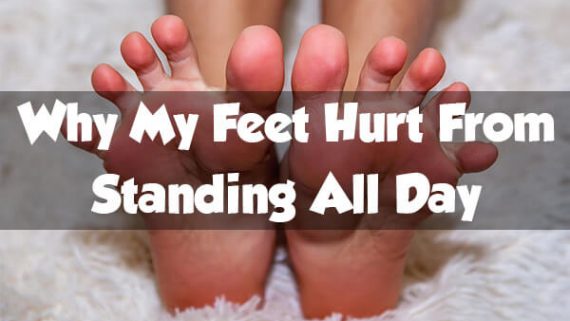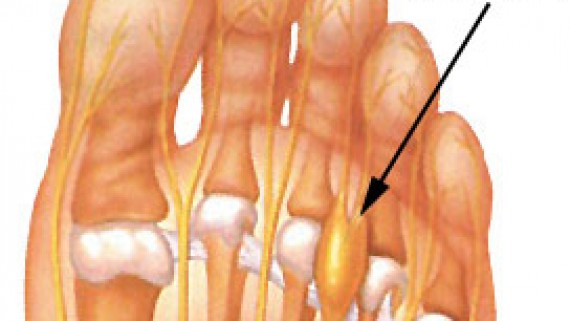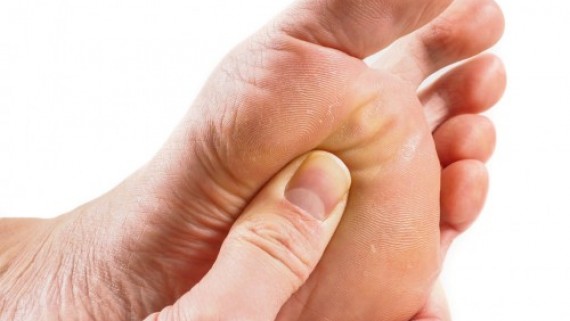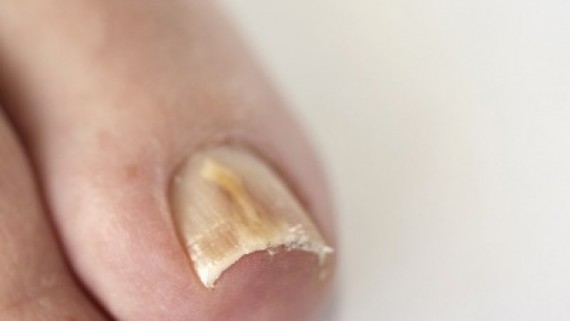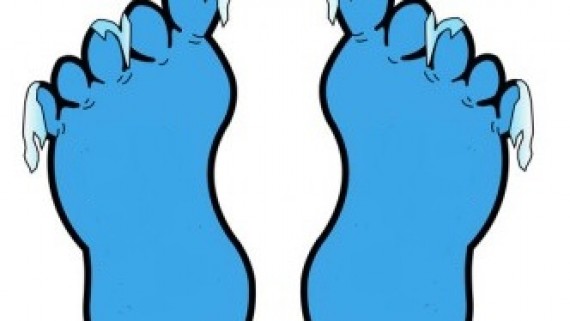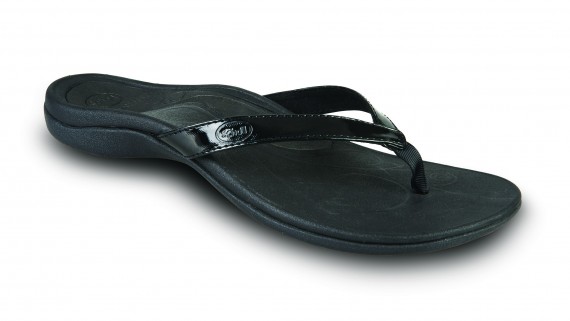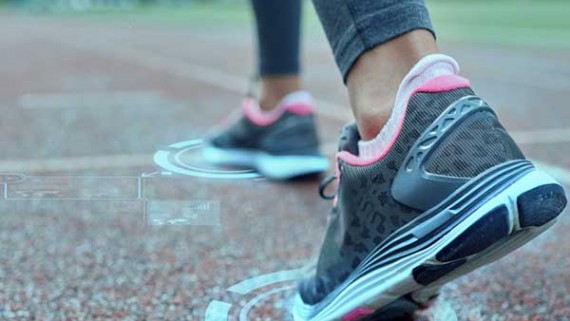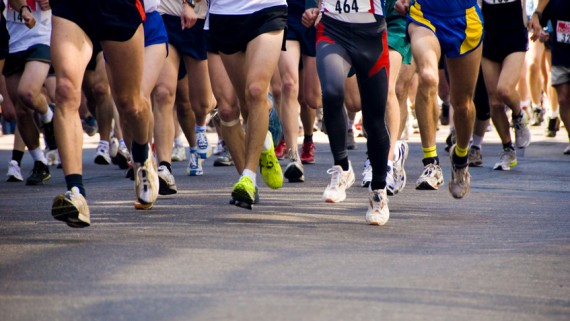There are many ways to make a living and for some of us it involves long periods of standing. In particular, jobs that require us to stand all day place an undue stress on our feet, legs, knees, and hips- Did someone say retail worker?
The main problem with standing for long periods of time is that you are placing a large amount of stress on the same muscle groups, ligaments and bones. This is why you can experience pain.
We are all probably a little guilty of fantasizing about quitting our jobs and finally chasing our dream career of becoming a travel show host for Getaway. But we better take a look at a few ways we can reduce pain in the feet, just in case that falls through.
Keeping good foot health while standing will require you to be proactive and take steps towards achieving more cushioning and support during your day to day work.
The last thing anyone wants is an injury that prevents you from working and therefore impacts your income. To the same degree none of us want to work with foot or leg pain either!
To help make it easier, let’s take a moment to answer the question of why my feet hurt from standing all day? And what we can do to help.
Why Do My Feet Hurt From Standing All Day?
People are meant to stand. The reason why it can be challenging and why our feet hurt is that we may not be ready for it without some planning. Many people changing to a more active job will find that pain in their feet occurs pretty quickly after starting. Some of this pain will go away naturally as your body gets accustomed to it. If the pain persists, then it may have something do with your shoes or your foot type.
Sometimes the surfaces that we work on can be a little unforgiving on our joints. Man-made surfaces like concrete and tiles don’t allow for much shock absorption and therefore our joints take all the load. This is where the right pair of shoes can help.
The lifespan of a pair of shoes will change dramatically based on what brand and style of shoe you are wearing. As well as how often you are wearing them and how many kilometres you do in a day.
Wearing the right shoes can dramatically reduce the amount of pain you feel from standing all day. Also, consider how long your shoe is meant to last. As the shoe breaks down from use, it will provide less and less cushion for your body, resulting in experiencing more discomfort.
It is important that you wear the right shoe for your foot type. Just because you spent $200 on a pair of shoes does not necessarily mean they are more supportive or that they are right for you!
The best way to make sure you are getting the right shoe is to book an appointment with one of our shoe addicted podiatrists to have your walking pattern assessed. We can then recommend the right shoe for you before you invest your money into the wrong one!
The bottom line
Don’t put up with unnecessary pain. We are here to help you and will work with you to meet the specific needs of your feet and job.
Call us on 1300 847 226 to make an appointment and give us the time to help you.
What is a Morton’s neuroma?
How did I get this?
If I had a Morton’s neuroma, what would it feel like?
What do I do next?
- Ice to the area
- Again ladies – avoid high heels!
- Check the width of your footwear. Try wearing wider shoes with a lower heel. Tighter or narrow footwear can compress and bunch the toes together. Your podiatrist can help you with footwear assessment and recommendations.
The exact cause of Morton’s neuroma can be different between patients. An accurate diagnosis can be made by a podiatrist.
- You may require orthotics to alleviate the forefoot pressure and mechanics in combination with metatarsal padding.
- Additional, ultrasound imaging maybe required to consider other diagnostic possibilities (as mentioned in first post).
- In more serve cases a course of anaesthetic and cortisone injections.
- Surgical removal of the neuroma as last resort.
Don’t forget, a neuroma is a result of a nerve that is being traumatised by a poorly functioning foot or footwear and treating the cause of this condition is paramount.
Metatarsalgia – Ball of Foot Pain
So many foot problems can occur in our forefoot. As podiatrists we treat a wide range of problems associated with forefoot pain and deformity. Metatarsalgia is a non-specific term or general umbrella term if you will, for pain in the forefoot or ball of the foot.
Discomfort is usually located beneath the balls of our feet and is typically a result of increased forefoot pressure.
Bunions, hammertoes, short metatarsal bones, stress fractures, plantar plate disruption, Freiberg’s infarction, capsulitis, intermetatarsal bursitis and Morton’s neuroma area some possible causes of metatarsalgia.
Today we are talking about intermetatarsal bursitis.
Intermetatarsal bursitis
What is bursitis?
An inflammation or irritation of the bursa. A bursa is a small fluid-filled sac that provides cushioning and reduces friction, between and around the joints of the forefoot. Irritation of the bursa can cause swelling and pain (bursitis). The intermetatarsal bursae are located on the bottom of the foot near the base of the toes.
Bursitis can also affect other parts of the body – back of the heel/Achilles tendon, the knee, hip, shoulder and elbow.
How did I get this?
Generally, bursitis can occur through injury or repetitive motion causing irritation and inflammation. They can become irritated when one metatarsal bone takes more load than others.
Wearing narrow or excessively worn footwear during the day and different sporting activities can increase your chance of developing bursitis. Other factors can include;
- Overuse or excessive pressure on the forefoot
- Stress from abnormal foot mechanics
- Injury from a fall or hit to the area
- Less commonly due to certain types of arthritis; rheumatoid arthritis, gout, psoriatic arthritis
If I had bursitis, what would it feel like?
Friction can cause the space between the tendon, bone and skin to become inflamed – causing swelling, pain and possibly redness of the surrounding area.
Irritation and restricted movement of the affected joint may be evident and certain footwear or activities may exacerbate pain.
What do I do next?
- Apply ice to the area – this can help reduce inflammation
- Rest and avoid painful activities
- Non-steroidal anti-inflammatories if advised by your pharmacist
- Orthotics
- Footwear changes, avoid high heels!
- Reduce the amount of pressure being place placed on the bursa through off loading
- In chronic cases, injections of local anaesthetic and corticosteroid may be required in combination with padding
It’s important to attend a podiatry consult for assessment to determine the root cause, as other injuries can produce similar symptoms. Podiatrist may advise you on appropriate shoes and can also add padding to off load the pressure, prescribe orthotics and refer for any imaging that may be needed to rule out other conditions.
Contact us on 1300 847 226 or make an appointment online to speak with one of our friendly podiatrists about helping you get back on your feet sooner!
The battle of the fungal nail!
Fungal toenails or onychomycosis is common, unpleasant and persistent in nature. Accounting for almost half of all nail problems, this slow growing infection occurs when microscopic fungi gain entry to the nail, usually through small trauma. Trauma allows the pathogen to enter the nail and nail bed.
Other causes
- Fungal organisms grow and spread in warm, moist environments and are usually picked up in warm damp areas like socks, shoes, public pools, gyms and showers.
- Not drying off the feet thoroughly following showers or exercise and wearing tight shoes or socks, can provide conditions the fungus needs for growth.
- People who have a compromised immune system, diabetes, circulatory problems and the elderly are particularly susceptible.
Symptoms
Fungal nail infections are contagious and can often spread from skin to nails. The poor cosmetic appearance that usually develops can cause some embarrassment. Nails can become discoloured, thickened, brittle, rough and weaken. Sometimes the infection can occur with an odour and can cause discomfort.
Types of Onychomycosis
Distal subungual onychomycosis – most common form of fungal nail that can cause the nail to become yellow brownish in colour, thickened, rough or crumbling.
Superficial white onychomycosis – this type of infection occurs on the outer surface and often appears as white spots. It is the easiest type of infection to treat.
Proximal subungual onychomycosis – occurs in the area of new nail growth at the beginning of the nail and is the least common.
Candida onychomycosis – typically occurs after trauma or damage to the nail that allows the fungus to invade. Most often occurs in people who frequently have their feet in water.
Treatment
As many people with fungal toenails can appreciate, it’s often difficult to eradicate fungal toenail infections, and like most things, prevention is always better than cure. Treatment varies depending on the type of fungal nail infection and the amount of nail involved, so it’s best to chat to your podiatrist who can recommend the best treatment option for your type of onychomycosis. In many cases nail lacquer medications are used, and in severe cases oral antifungal medication from your doctor, however this comes with potential side-effects.
Preventative measures
- Wear protective shoes in public showers and pool areas.
- Wash your feet regularly and dry them thoroughly when they get wet.
- Change socks daily, more regularly if you have increase perspiration or exercise.
- Avoid leaving toenail polish in place for long periods of time, wearing nail polish is not advised for those people who are suffering from nail fungus as it may encourage it to grow.
- Avoid nail solons who re-use their nail instruments, all instruments should be sterilised using an autoclave.
- Wear properly fitting shoes
If you suspect a toenail fungus, it’s recommended you see your podiatrist before it spreads. Podiatrists also have a tool to reduce thickness of fungal nails, this can enable topical medication to absorb and penetrate the nail easier, provide comfort of thickened nails and can help improve the appearance of the nail.
If you or someone you know would benefit from fungal nail treatment, please give us a call or book an appointment online at any of our podiatry clinics in Warragul, Drouin, Beaconsfield or Cranbourne.
We know how much you love to be active, we love it too! Our friendly team are here to help keep your feet happy and healthy. Contact us for an appointment at our Cranbourne, Beaconsfield, Drouin or Warragul Clinics or make an appointment online.
Summer Footwear
During an Australian Summer it is very clear that everybody’s favourite summer footwear are thongs. They are so easy to slip on, don’t require any bending down to put on or fiddling with any laces. Throughout history there has been a war between thongs and Podiatrists; thongs have typically been flat pieces of rubber that offer no support and by the end of the day have everyone begging for a foot massage. Well, no more! The War has finally ended and I am happy to say that both sides have won.
There are thongs that now offer arch support. You can walk around all day without the same discomfort you used to have from your old pair of thongs. The best part is that they are stylish as well as comfortable. Come into our Warragul clinic to check them out.
Lynette Stokie
Your Freindly Neighbourhood Podiatrist
Free Podiatry Footwear Assessment
The Podiatry Group are offering Free Podiatry Footwear Assessments at Nicho’s Intersport in Warragul.
If you have trouble picking the right runner or shoe for your feet, or have any podiatry footwear related questions come on down and one of our podiatrists will assist you.
The Podiatry Group will be at Nicho’s Intersport (21 Smith Street Warragul) on Tuesday November 10th 4:30-5:30pm.
To make an appointment contact Nichos’ Intersport on 5622 3844.
Click on Nicho’s Intersport to check out the details of their store.
Melbourne Marathon Podiatry Tips
At The Podiatry Group we are often asked for our top tips when training for a marathon. With the Melbourne Marathon coming up we have decided to give you a little insight to some helpful guidelines to consider when training and running in a marathon. The internet can provide a whole text book of information from how to carb load before an event to the best anti chafing stick to use. We will let you in on the best advice we provide for runner’s feet during their marathon.
- Get your runners professionally fitted. There are stores like Active Feet who are highly trained to fit running shoes. They can observe your running and walking patterns on a treadmill to better assess which shoe is most appropriate for you. Remember that runners will only last on average between 600-800kms so if you have been training hard make sure that by the time you reach your marathon day, your shoes still have life in them. If you are considering purchasing a new pair of shoes before your marathon, make sure that you have enough time to wear them in slowly before the big day. This means that you should have them at least 2 weeks before your event and begin wearing them in at home for a few hours and gradually progressing to a walk then a run. If you are purchasing the same brand and style as your last shoe make sure you speak with the person selling you your shoes to see if there have been any significant changes between the last and latest model. Sometimes the heel height (heel pitch) of a shoe will reduce or increase compared to the forefoot. This may alter the way that you run and impact the style of running you have trained for. At The Podiatry Group we are able to help assess your runners and ensure they are the right shoe for your running style and technique.
- Make sure you have the right socks. This may seem a silly statement; some of you may think that all socks are equal. We are here to tell you that they are not. There are socks that are designed to help prevent blistering. A small blister might not seem too daunting, but over a 42km run it can slowly but surely cause you more discomfort then you could imagine. There are socks that are specifically designed to wick moisture away from the feet leaving them dry. Some brands that are able to do this are Thorlo, Wigwam and Injinji.
- Make sure your nails are cut! Cut your nails before an event but leave 1mm of nail growth at the end (1mm of the white part of the nail), this will ensure you don’t cut the too short and bleed causing a bit of a mess and some sore toes before you even begin running. This will also help minimise the risk of your nails going black from bruising or even losing your nails after a marathon. Sometimes our nails get blackened or fall off after an event like a marathon from repetitive micro-trauma. This can be where our toes hit the end of our shoes when running causing micro damage to the nail. This can also be due to our shoes not being laced properly.
- Get rid of that build up of hard skin! If you have callous on your feet then odds are you have a lot of pressure and friction occurring at that site. If you would like this professionally removed then contact us. If you only have a small amount and think you can manage yourself then the best way is to use a pumice stone. A pumice stone must be used wet (in the bath or shower), it is best used if you rub the pumice stone on a cake of soap and then on the hardened skin until you have taken enough off.
- Compression stockings can help aid recovery time. It has been shown that an average persons calf will expand in diameter after standing for 1-3 hours. As such, you can imagine that when running a marathon (which could take anywhere between 3-5 hours depending on your speed) your calf will expand and could cause discomfort and a feeling of fatigue. We recommend that all runners consider compression stockings. Please note that we strongly advise that a runner come in for an assessment before using a high grade compression stocking.
- Have fun! You may choose to run a marathon only once in your life or you may be crazy enough to run many times. Our most important tip we could give you is to enjoy it. You’ve worked so hard to get to where you are, all those training sessions, all that blood sweat and tears, just don’t forget to enjoy yourself.
If you are training for a marathon and want to speak with one of our Podiatrists then you can contact us. We have Podiatry Clinics located in Cranbourne, Drouin and Warragul.

